Garbha Upanishad
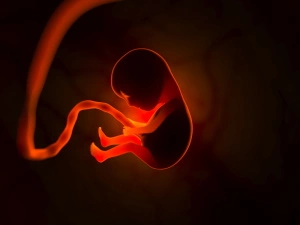
Garbha Upanishad is one among the 108 Upanishads.
Its author is Pippalada Maharshi.
Garbha Upanishad deals with the conception, and development of the embryo both from a physiological and spiritual angle.
The ultimate aim of the Upanishad is to make the sadhaka realize the mundane nature of worldly life and turn him towards attaining moksha.
Click below to listen to Garbha Rakshambika Stotra
What is the body composed of?
The Panchabhutas or the five elements.
- Prithvi - whatever is solid.
- Jalam - whatever is liquid.
- Agni - the heat in the body.
- Vayu - all the movements of and within the body.
- Akasha - Space in which the body exists and also the cavities and tube-like spaces inside the body.
What are the roles of the Panchabhutas?
- Prithvi - supporting objects.
- Jalam - cohesion ( like how particles of dry soil when mixed with water are held together and become mud).
- Agni - makes objects visible
- Vayu - causes movements.
- Akasha - gives space.
The five sensory organs (jnanendriyas)
- Eyes - for seeing.
- Ears - for hearing.
- Tongue - for tasting.
- Nose - for smelling.
- Skin - for feeling touch.
The five organs of action (karmendriyas)
- Mouth - for speaking.
- Hands - for holding and lifting.
- Legs - for walking.
- Anus - for excreting.
- Genitals - for enjoying.
The four internal organs (antah karana)
- Buddhi - for knowing, determining, and discriminating.
- Manah - for thinking, and imagining.
- Chitta - for remembering.
- Ahamkara - to have the notion of I and Mine.
The six essences (rasas)
- Sweet (madhura)
- Sour (amla)
- Saltish (lavana)
- Bitter (tikta)
- Pungent (katu)
- Astringent (kashaya)
They are not merely tastes.
The functioning of the body depends on these.
For example, too much sweetness in the body is called diabetes.
Too much pungency can cause ulcers.
The pH value of the body should be between 7.35-7.45 which largely depends on the amla rasa.
The body is called shadashraya - dependent on the six - due to this.
The six changes of state of the body
The body -
- comes into existence.
- is born.
- grows.
- matures.
- decays.
- dies.
The six chakras of the body
- Muladhara
- Swadhishtana
- Manipura
- Anahata
- Vishuddhi
- Ajna
They are the hubs of the movements of life forces within the body.
The seven kinds of sound
- Shadja
- Rishabha
- Gandhara
- Madhyama
- Panchama
- Dhaivata
- Nishada
The qualities such as passion, and devotion combine with these sounds and form spoken sound (speech).
Some words are agreeable, some are not.
The dhatus (tissues) have got seven different colors
- White (chyme or rasa)
- Red (blood)
- Opaque (flesh)
- Grey (fat)
- Yellow (bone)
- Brown (marrow)
- Yellowish white (semen)
How the tissues are formed
- From the essence of food (rasa) blood.
- From blood flesh.
- From flesh fat.
- From fat bones.
- From bone marrow.
- From marrow semen.
How the embryo is formed
The male semen (shukra) combines with the female ovum (shonita) to form the embryo.
The development of the embryo
The embryo is fluid on the first night.
In seven days, it becomes like a bubble.
In fifteen days it becomes a ball.
In one month, it becomes hard.
In two months, the head is formed.
In three months, the feet are formed.
In the fourth month, the stomach and ankles are formed.
In the fifth month, the spinal column and back are formed.
In the sixth month, the face, nose, eyes, and ears are formed.
In the seventh month, the jivatma enters the body.
By the eighth month, all organs are fully developed.
Gender of the child
If the semen is more powerful, a male child is born.
If the ovum is more powerful, a female child is born.
If both are equal, a eunuch is born.
Since the female derives more pleasure from the intercourse, more females are born.
Children with defects
If the parents have anxiety or stress at the time of copulation, then the child with defects is born.
Examples of this can be found in Mahabharata.
Ambika closed her eyes in fear when she united with Vyasa; her son Dhritarashtra was born blind.
Ambalika became pale with fear when she united with Vyasa; her son Pandu was born anemic and sick.
Intercourse during forbidden times such as the eclipses will lead to the birth of defective children.
Nature of the child
If the intercourse is pleasant and affectionate, then the child will inherit all the good qualities of the father.
The place, time, action, and enjoyment of the intercourse influence the nature of the child.
Birth of twins
Multiple intercourses or splitting of the sperms or ovum lead to the birth of twins.
If only one among the sperm and ovum splits, then the sex of twins will be the same.
If both split, then twins of nonidentical sex are born.
If the sperm or ovum split into more than two, then multiple births such as quintuplets take place.
What happens in the ninth month?
The body made up of the five elements is fully developed.
It becomes ready to perceive through the sensory organs.
The fetus has deep wisdom at this stage.
It cognizes the beginningless and endless Omkara.
The eight prakritis become active in the body.
They are: Mulaprakriti, mahat, ahamkara, and the Panchabhutas.
The sixteen vikaras become active in the body.
They are: The five jnanedriyas, the five karmendriyas, the five pranas, and the antah karana.
Prana is fully infused into the fetus through the blood of the mother (via the umbilical cord).
Then it remembers the previous births - the acts committed and left undone.
It discriminates between the right and wrong that have been committed.
Then the fetus thinks-
I have seen thousands of wombs.
I have suckled thousands of breasts.
I have tasted thousands of different foods.
I have taken birth at places all over the world.
I have died at places all over the world.
I have been taking births in the 84 lacs of different species.
I am in this perpetual cycle of rebirths.
It has always been birth-death, birth-death, birth-death..
There is suffering inside the womb.
Every birth is filled with delusion and sorrow.
During young age, there is dependence on others, ignorance, grief, not doing what is beneficial and doing what is harmful.
During adulthood, there is attachment to sensory pleasures, and the three kinds of sufferings - caused by external objects and beings, self-inflicted, and those caused by supernatural forces.
In old age, there are unfulfilled desires, fear of death, anxiety, lack of independence, and anger.
Taking birth is the starting of all these.
I have not been able to come out of the cycle of rebirths.
I have not acquired the knowledge of jnana and yoga.
I have drowned in this ocean of suffering.
I do not know how to come out of it.
Fie on my ignorance!
Fie on troubles caused by passion!
Fie on troubles caused by anger!
Fie on this mundane existence.
I shall acquire knowledge from a Guru.
I shall practice Sankhya-yoga.
That will release me from all shackles.
That will end all my troubles.
Once I come out of the womb, I shall take refuge in Maheshwara.
He will equip me with the means to attain the four goals of life: dharma, artha, kama, and moksha.
I shall take refuge in the Lord of the world, Chidatma.
He is at the core of all powers.
He is behind everything that happens.
Once I come out of the womb, I shall take refuge in Bharga.
He is the light of the world.
He is the lord of all beings, living and nonliving.
He is Rudra, Mahadeva, and the teacher of the world.
Once I come out of the womb, I shall perform tapas.
Once I come out of the womb, I shall worship Vishnu.
He bestows the nectar of bliss.
He is the changeless Narayana.
Now I am caught inside this womb.
Once I come out of the womb, I shall focus on the great Vasudeva.
I shall never take my mind away from him.
Those who benefited from my past deeds have all disappeared.
Only I am left to suffer the consequences of my karma.
I have been a non-believer.
I never thought that I alone would have to suffer the consequences of my actions.
Now, I know that it is true.
The jivatma of the fetus goes on contemplating like this.
It finds its own desires, ignorance and mundane actions disgusting.
What happens during birth?
In this state, the fetus comes to the mouth of the womb.
It wants to come out.
There, it suffers a lot as it passes through the neck of the womb.
It is tormented by the Prasuti-vayu, the force that causes the delivery.
As soon as the child comes out it comes in contact with the Vaishnavi-vayu.
The Vaishnavi-vayu erases all memories about past births.
It loses its farsightedness.
It loses the ability to see reality.
As soon as it comes in contact with the earth, the child becomes ready to cry.
The tears of the first cry wash away the remaining memories.
Its ability to discriminate between the right and the wrong is gone.
The tridoshas
Vata, pitta, and kapha should be in a balanced state in the body.
Otherwise, they produce diseases.
The Agni in the body
Pitta is the agni in the body.
One will be able to think correctly only if pitta is in the right quantity.
If pitta is more, he will become mentally deranged.
Why is the body called sharira?
Because three Agnis keep on burning in it.
साक्षादग्नयो ह्यत्र श्रियन्ते ज्ञानाग्निर्दर्शनाग्निः कोष्ठाग्निरिति ।
The fire in the body is of three types.
Jnanagni - energy responsible for the processes of the mind and intelligence.
Darshanagni - energy that acquires information through the sensory organs.
Koshtagni - energy that digests food.
The perpetual yaga in the body
The body can be compared to a yaga-vedi.
There are three homa kundas in the yaga-vedi; Garhapatya, Ahavaniya, and Dakshinagni.
Among these, Garhapatya is the belly, Ahavaniya is the mouth, and Dakshinagni is the heart.
The purusha (living being) himself is the yajamana.
His intelligence is the wife.
Contentment is the vow that he observes.
Indriyas and the mind are the vessels.
The Devas present in the body are the purohitas.
The supervisor of the yaga is the mind.
They follow the yajamana wherever he goes.
Desires are the ghee offered in Agni.
Greed, anger, etc. are sacrificial animals.
The duration of the yaga is the lifespan of the person.
The nada in the heart is the Samas.
Para, Pashyanti, and Madhyama are the Richas.
Vaikhari is Yajus.
The culmination of this yaga is death.
This sacrifice is going on inside every single living being.
Devas bless them.
Anatomy of the human body
The skull is made of 4 bones.
There are 16 teeth in each row.
There are 107 marmas.
There are 72 nadis.
Three of them are most important: Ida, Pingala, and Sushumna.
There is a nadi called Jivata above which is the source of bile.
This is two angulas to the left of the navel.
The food gets converted into chyme (rasa), urine, and feces.
The semen and ovum are produced from food and drink.
All the movements inside the body including blood circulation take place with the help of Vata (Vayu).
Initially, the prana of the fetus is at the Ajna chakra.
By the time it is ready for delivery it descends and settles at the Anahata chakra.
There are 45 million hairs.
The heart weighs eight palams.
The tongue weighs twelve palams.
The bile (pitta) in the body weighs one prastha.
The kapha weighs one adhaka.
The marrow weighs two prasthas.
The semen weighs one kudava.
Knowing all this, one should develop vairagya and strive to attain moksha.
This is the moksha-shastra given by Pippalada.
गर्भोपनिषत्
यद्गर्भोपनिषद्वेद्यं गर्भस्य स्वात्मबोधकम् ।
शरीरापह्नवात्सिद्धं स्वमात्रं कलये हरिम् ॥
ॐ सह नाववतु । सह नौ भुनक्तु । सह वीर्यं करवावहै । तेजस्विनावधीतमस्तु मा विद्विषावहै । ॐ शान्तिः शान्तिः शान्तिः ॥
ॐ पञ्चात्मकं पञ्चसु वर्तमानं षडाश्रयं षड्गुणयोगयुक्तम् ।
तत्सप्तधातु त्रिमलं द्वियोनि चतुर्विधाहारमयं शरीरं भवति ॥
पञ्चात्मकमिति कस्मात् पृथिव्यापस्तेजोवायुराकाशमिति ।
अस्मिन्पञ्चात्मके शरीरे का पृथिवी का आपः किं तेजः को वायुः किमाकाशम् ।
तत्र यत्कठिनं सा पृथिवी यद्द्रवं ता आपो यदुष्णंतत्तेजो यत्सञ्चरति स वायुः यत्सुषिरं तदाकाशमित्युच्यते ॥
तत्र पृथिवी धारणे आपः पिण्डीकरणे तेजः प्रकाशनेवायुर्गमने आकाशमवकाशप्रदाने । पृथक् श्रोत्रे शब्दोपलब्धौ त्वक् स्पर्शे चक्षुषी रूपे जिह्वा रसने नासिकाऽऽघ्राणे उपस्थश्चानन्दनेऽपानमुत्सर्गे बुद्ध्या बुद्ध्यति मनसा सङ्कल्पयति वाचा वदति ।
षडाश्रयमिति कस्मात् मधुराम्ललवणतिक्तकटुकषायरसान्विन्दते ।
षड्जर्षभगान्धारमध्यमपञ्चमधैवतनिषादाश्चेति ।
इष्टानिष्टशब्दसंज्ञाः प्रतिविधाः सप्तविधा भवन्ति ॥ १॥
शुक्लो रक्तः कृष्णो धूम्रः पीतः कपिलः पाण्डुर इति ।
सप्तधातुमिति कस्मात् यदा देवदत्तस्य द्रव्यादिविषयाजायन्ते ॥
परस्परं सौम्यगुणत्वात् षड्विधो रसो रसाच्छोणितं शोणितान्मांसं मांसान्मेदो मेदसः
स्नावा स्नाव्नोऽस्थीन्यस्थिभ्यो मज्जा मज्ज्ञः शुक्रं शुक्रशोणितसंयोगादावर्तते गर्भो हृदि व्यवस्थां नयति ।
हृदयेऽन्तराग्निः अग्निस्थाने पित्तं पित्तस्थाने वायुः वायुस्थाने हृदयं प्राजापत्यात्क्रमात् ॥ २॥
ऋतुकाले सम्प्रयोगादेकरात्रोषितं कलिलं भवति सप्तरात्रोषितं बुद्बुदं भवति अर्धमासाभ्यन्तरेण पिण्डो भवति मासाभ्यन्तरेण कठिनो भवति मासद्वयेन शिरः
सम्पद्यते मासत्रयेण पादप्रवेशो भवति ।
अथ चतुर्थे मासे जठरकटिप्रदेशो भवति ।
पञ्चमे मासे पृष्ठवंशो भवति ।
षष्ठे मासे मुखनासिकाक्षिश्रोत्राणि भवन्ति ।
सप्तमे मासे जीवेन संयुक्तो भवति ।
अष्टमे मासे सर्वसम्पूर्णो भवति ।
पितुः रेतोऽतिरिक्तात् पुरुषो भवति ।
मातुः रेतोऽतिरिक्तात्स्त्रियो भवन्त्युभयोर्बीजतुल्यत्वान्नपुंसको भवति ।
व्याकुलितमनसोऽन्धाः खञ्जाः कुब्जा वामना भवन्ति ।
अन्योन्यवायुपरिपीडितशुक्रद्वैध्याद्द्विधा
तनुः स्यात्ततो युग्माः प्रजायन्ते ॥
पञ्चात्मकः समर्थः पञ्चात्मकतेजसेद्धरसश्च सम्यग्ज्ञानात् ध्यानात् अक्षरमोङ्कारं चिन्तयति ।
तदेतदेकाक्षरं ज्ञात्वाऽष्टौ प्रकृतयः षोडश विकाराः शरीरे तस्यैवे देहिनाम् ।
अथ मात्राऽशितपीतनाडीसूत्रगतेन प्राण आप्यायते ।
अथ नवमे मासि सर्वलक्षणसम्पूर्णो भवति पूर्वजातीः स्मरति कृताकृतं च कर्म विभाति
शुभाशुभं च कर्म विन्दति ॥ ३॥
नानायोनिसहस्राणि दृष्ट्वा चैव ततो मया ।
आहारा विविधा भुक्ताः पीताश्च विविधाः स्तनाः ॥
जातस्यैव मृतस्यैव जन्म चैव पुनः पुनः ।
अहो दुःखोदधौ मग्नः न पश्यामि प्रतिक्रियाम् ॥
यन्मया परिजनस्यार्थे कृतं कर्म शुभाशुभम् ।
एकाकी तेन दह्यामि गतास्ते फलभोगिनः ॥
यदि योन्यां प्रमुञ्चामि सांख्यं योगं समाश्रये ।
अशुभक्षयकर्तारं फलमुक्तिप्रदायकम् ॥
यदि योन्यां प्रमुञ्चामि तं प्रपद्ये महेश्वरम् ।
अशुभक्षयकर्तारं फलमुक्तिप्रदायकम् ॥
यदि योन्यां प्रमुञ्चामि तं प्रपद्ये भगवन्तं नारायणं देवम् ।
अशुभक्षयकर्तारं फलमुक्तिप्रदायकम् ।
यदि योन्यां प्रमुञ्चामि ध्याये ब्रह्म सनातनम् ॥
अथ जन्तुः स्त्रीयोनिशतं योनिद्वारि सम्प्राप्तो यन्त्रेणापीड्यमानो महता दुःखेन जातमात्रस्तु
वैष्णवेन वायुना संस्पृश्यते तदा न स्मरति जन्ममरणं न च कर्म शुभाशुभम् ॥ ४॥
शरीरमिति कस्मात् साक्षादग्नयो ह्यत्र श्रियन्ते ज्ञानाग्निर्दर्शनाग्निः कोष्ठाग्निरिति ।
तत्र कोष्ठाग्निर्नामाशितपीतलेह्यचोष्यं पचतीति ।
दर्शनाग्नी रूपादीनां दर्शनं करोति । ज्ञानाग्निः शुभाशुभं च कर्म विन्दति ।
तत्र त्रीणि स्थानानि भवन्ति हृदये दक्षिणाग्निरुदरे गार्हपत्यं मुखमाहवनीयमात्मा यजमानो बुद्धिं पत्नीं निधाय मनो ब्रह्मा लोभादयः पशवो धृतिर्दीक्षा सन्तोषश्च बुद्धीन्द्रियाणि यज्ञपात्राणि कर्मेन्द्रियाणि हवींषि शिरः कपालं केशा दर्भा मुखमन्तर्वेदिः चतुष्कपालं शिरः षोडश पार्श्वदन्तोष्ठपटलानि सप्तोत्तरं मर्मशतं साशीतिकं सन्धिशतं सनवकं स्नायुशतं सप्त शिराशतानि पञ्च मज्जाशतानि अस्थीनि च ह वै त्रीणि शतानि षष्टिश्चार्धचतस्रो रोमाणि कोट्यो हृदयं पलान्यष्टौ द्वादश पलानि जिह्वा पित्तप्रस्थं कफस्याढकं शुक्लं कुडवं मेदः प्रस्थौ द्वावनियतं मूत्रपुरीषमाहारपरिमाणात् ।
पैप्पलादं मोक्षशास्त्रं परिसमाप्तं पैप्पलादं मोक्षशास्त्रं परिसमाप्तमिति ॥
ॐ सह नाववतु । सह नौ भुनक्तु । सह वीर्यं करवावहै । तेजस्विनावधीतमस्तु मा विद्विषावहै । ॐ शान्तिः शान्तिः शान्तिः ॥
What does Gabha mean?
Garbha in Sanskrit means the embryo. गीर्यते जीवसञ्चितफलदात्रा ईश्वरेण जठरगह्वरे स्थाप्यते इति गर्भः - to undergo the results of one’s own past karma, the almighty places it in the cavity of the belly.
Who wrote Garbha Upanishad?
Pippalada Maharshi. Garbha Upanishad is associated with Krishna Yajurveda.
Quiz
Which Veda is Ishavasya Upanishad connected to?Other languages: Hindi
Recommended for you
Khidkali Mahadev Mandir
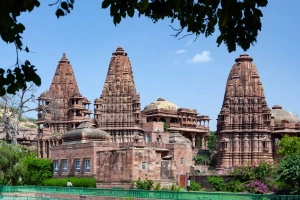
A powerful Shiva mandir where the Pandavas offered worship during their exile....
Click here to know more..Do you know that Sri Hari observes everything that everyone does?
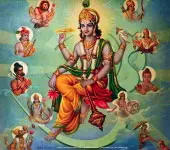 Click here to know more..
Click here to know more..
Rajarama Dashakam
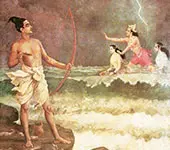
mahaaveeram shooram hanoomachchittesham. dri'd'haprajnyam dheeram bhaje nityam raamam. janaanande ramyam nitaantam raajendram. jitaamitram veeram bhaj....
Click here to know more..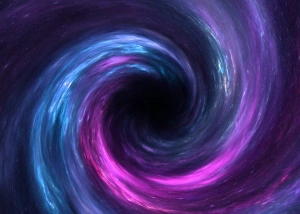
English Topics
Mystique
Click on any topic to open
- 31 Death is a New Beginning
- 30 Kinetic Energy, Potential Energy, And The Universe
- 29 What Is The Need For Bhakti Yoga?
- 28 How does it feel when Kundalini is awakened?
- 27 Why Rudra Is Saluted Twice
- 26 Difference Between Jeeva, Ishwara, and Parameshwara
- 25 Some Folk Beliefs In Ancient Maharashtra
- 24 What Is Vedanta?
- 23 Who Will You Be In Your Next Birth?
- 22 Garbha Upanishad
Please wait while the audio list loads..
30
Ganapathy
Shiva
Hanuman
Devi
Vishnu Sahasranama
Mahabharatam
Practical Wisdom
Yoga Vasishta
Vedas
Rituals
Rare Topics
Devi Mahatmyam
Glory of Venkatesha
Shani Mahatmya
Story of Sri Yantra
Rudram Explained
Atharva Sheersha
Sri Suktam
Kathopanishad
Ramayana
Mystique
Mantra Shastra
Bharat Matha
Bhagavatam
Astrology
Temples
Spiritual books
Purana Stories
Festivals
Sages and Saints

